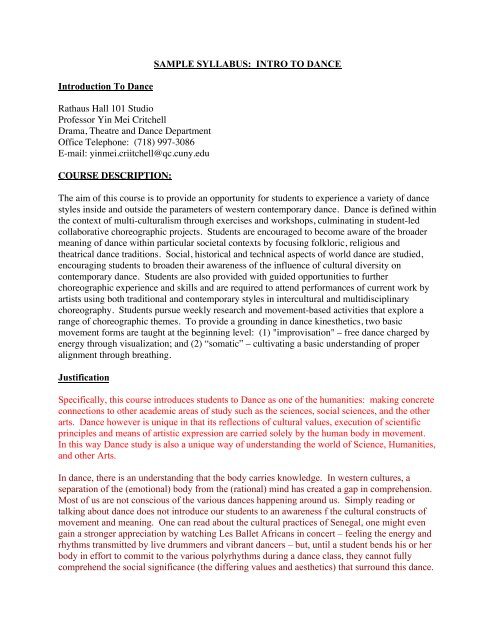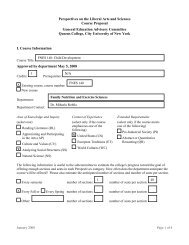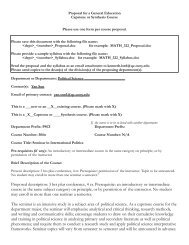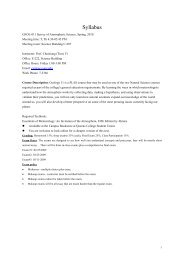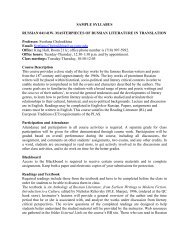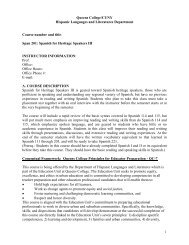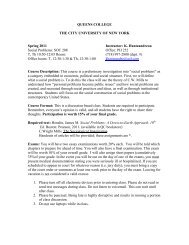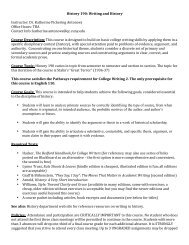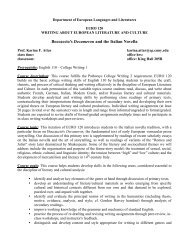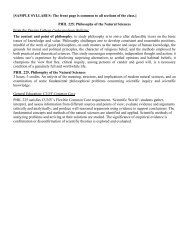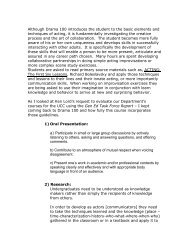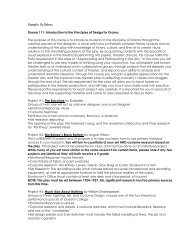SAMPLE SYLLABUS: INTRO TO DANCE Introduction To ... - CUNY
SAMPLE SYLLABUS: INTRO TO DANCE Introduction To ... - CUNY
SAMPLE SYLLABUS: INTRO TO DANCE Introduction To ... - CUNY
You also want an ePaper? Increase the reach of your titles
YUMPU automatically turns print PDFs into web optimized ePapers that Google loves.
<strong>Introduction</strong> <strong>To</strong> Dance<br />
Rathaus Hall 101 Studio<br />
Professor Yin Mei Critchell<br />
Drama, Theatre and Dance Department<br />
Office Telephone: (718) 997-3086<br />
E-mail: yinmei.criitchell@qc.cuny.edu<br />
COURSE DESCRIPTION:<br />
<strong>SAMPLE</strong> <strong>SYLLABUS</strong>: <strong>INTRO</strong> <strong>TO</strong> <strong>DANCE</strong><br />
The aim of this course is to provide an opportunity for students to experience a variety of dance<br />
styles inside and outside the parameters of western contemporary dance. Dance is defined within<br />
the context of multi-culturalism through exercises and workshops, culminating in student-led<br />
collaborative choreographic projects. Students are encouraged to become aware of the broader<br />
meaning of dance within particular societal contexts by focusing folkloric, religious and<br />
theatrical dance traditions. Social, historical and technical aspects of world dance are studied,<br />
encouraging students to broaden their awareness of the influence of cultural diversity on<br />
contemporary dance. Students are also provided with guided opportunities to further<br />
choreographic experience and skills and are required to attend performances of current work by<br />
artists using both traditional and contemporary styles in intercultural and multidisciplinary<br />
choreography. Students pursue weekly research and movement-based activities that explore a<br />
range of choreographic themes. <strong>To</strong> provide a grounding in dance kinesthetics, two basic<br />
movement forms are taught at the beginning level: (1) "improvisation" – free dance charged by<br />
energy through visualization; and (2) “somatic” – cultivating a basic understanding of proper<br />
alignment through breathing.<br />
Justification<br />
Specifically, this course introduces students to Dance as one of the humanities: making concrete<br />
connections to other academic areas of study such as the sciences, social sciences, and the other<br />
arts. Dance however is unique in that its reflections of cultural values, execution of scientific<br />
principles and means of artistic expression are carried solely by the human body in movement.<br />
In this way Dance study is also a unique way of understanding the world of Science, Humanities,<br />
and other Arts.<br />
In dance, there is an understanding that the body carries knowledge. In western cultures, a<br />
separation of the (emotional) body from the (rational) mind has created a gap in comprehension.<br />
Most of us are not conscious of the various dances happening around us. Simply reading or<br />
talking about dance does not introduce our students to an awareness f the cultural constructs of<br />
movement and meaning. One can read about the cultural practices of Senegal, one might even<br />
gain a stronger appreciation by watching Les Ballet Africans in concert – feeling the energy and<br />
rhythms transmitted by live drummers and vibrant dancers – but, until a student bends his or her<br />
body in effort to commit to the various polyrhythms during a dance class, they cannot fully<br />
comprehend the social significance (the differing values and aesthetics) that surround this dance.
They cannot own the knowledge in their own body as to how these African dances signify<br />
culture as opposed to a Baroque Pavane, a ballet pas de chat, a Graham contraction, a jazz<br />
layback or a breakdancing six-step.<br />
In dance, doing is knowing. A dance student is both participant and observer. The Intro to<br />
Dance course serves as experiential gateway for cultural understanding that cannot be gained in a<br />
non-physical manner. The efforts of the body allow the mind to recognize some of the inherent<br />
but not explicit meanings that movement vocabularies transmit. By integrating<br />
historical/contextual lectures and studio based practice, we can offer our students a more<br />
comprehensive system for learning and engender a lifelong pursuit of knowledge beyond the<br />
classroom.<br />
The overall aim of this course is to provide – through research, discussion, and (most importantly<br />
through) experiential participation – a contextual framework for students to broaden their<br />
perceptions of world dance and choreography. This course is unique in that it focuses on how<br />
movements of the human body (often as experienced directly by the student) convey personal<br />
and cultural values of the individual and the group. The course provides a framework for: (1)<br />
exploring and experiencing different ways of moving (with reflection on how these movements<br />
carry meaning); (2) developing skills for observing dance through the viewing of live and<br />
videotaped performances; (3) developing a vocabulary for describing and discussing dance (in a<br />
variety of contexts); (4) developing personal creativity, performance and choreographic skills<br />
through the completion of a choreographic project to be performed in class; (5) (learning how the<br />
body and its movements carry cultural values) and (6) demonstrating an ability to compare and<br />
contrast (a variety of different cultural value systems) in dance and to relate that body-knowledge<br />
to contemporary dance.<br />
In this way, dance is explored both from an internal (or participatory) perspective and from an<br />
external (or societal) perspective. THROUGH <strong>INTRO</strong>DUCTIONS <strong>TO</strong> IMAGES AND THEIR<br />
OWN ACQUISITION OF EXPERIENTIAL KNOWLEDGE OF MOVEMENT FORMS FROM<br />
AROUND THE WORLD, STUDENTS ARE ABLE <strong>TO</strong> INCREASE THEIR<br />
UNDERSTANDING OF THE VALUE OF <strong>DANCE</strong> IN CONTEMPORARY SOCIETY AND<br />
THE LARGER GLOBAL COMMUNITY.<br />
COURSE OBJECTIVES:<br />
(1) <strong>To</strong> explore and experience different ways of moving.<br />
(2) <strong>To</strong> develop a vocabulary for describing and discussing dance.<br />
(3) <strong>To</strong> develop skills for observing dance through the viewing of live and videotaped<br />
performances.<br />
(4) <strong>To</strong> develop personal creativity, performance and choreographic skills through the completion<br />
of a choreographic project to be performed in class.<br />
(5) <strong>To</strong> learn about different cultures through their dances.<br />
(6) <strong>To</strong> demonstrate an ability to compare and contrast cultural contexts in dance and to relate that<br />
knowledge to contemporary dance.
REQUIREMENTS:<br />
(1) Attendance in class and at performance events.<br />
(2) Journal/notebook assignment. You are required to keep a typed journal containing your<br />
reflections and responses to our class practice and readings/viewings. You are expected to write<br />
every week approximately 200 words.<br />
(3) Research assignment: Complete two page typed research paper on selected choreographer<br />
and present to class.<br />
(3) Complete three page typed essay on assigned performances. The paper should incorporate<br />
vocabulary developed in class and demonstrate observations of elements of dance as covered in<br />
class. The paper is due one week after the performance.<br />
(4) Choreographic project. This project may be done individually or in pairs or small groups.<br />
The projects will be performed in class on the last two days of class and during finals. The<br />
project will be evaluated for originality, performance and overall impact.<br />
(5) Final exam – movement (improvisation and yoga elements).<br />
METHOD OF EVALUATION:<br />
-- Class participation, attendance and punctuality<br />
-- Completion and quality of written assignments (including diary)<br />
-- Choreographic project<br />
-- Demonstration of understanding of basic materials covered in class<br />
ATTEN<strong>DANCE</strong>:<br />
Regular attendance is required and is an important determinant of your grade. Students are<br />
responsible for any material covered in missed classes. If unable to participate directly due to<br />
injury or illness, attend and observe the class if possible. Please be On TIME.<br />
CLOTHING:<br />
Loose clothes (such as sweat pants and shirt). NO JEANS.<br />
Yoga mat<br />
STUDIO RULES:<br />
(1) No eating, drinking, chewing gum allowed in the studio.<br />
(2) No street shoes allowed in the studio under any circumstances.<br />
(3) Never leave personal belongings unattended outside the dance studios at any time.<br />
(4) Use the dressing room, which is locate downstairs. Dance majors and miners are<br />
permitted to establish lockers for the semester. Students must bring a lock.<br />
RESEARCH ASSIGNMENT:
Select one of the following artists each week to research and present to the class. Complete a<br />
two page typed paper discussing the artist’s biographical background, body of work, and<br />
essential thematic focus. Choose from the following choreographers:<br />
Isadora Duncan<br />
Merce Cunningham<br />
John Cage<br />
Mary Wigman<br />
Hanye Holm<br />
Alvin Ailey<br />
Anna Halprin<br />
Yvonne Rainer<br />
Trisha Brown<br />
Twyla Tharp<br />
Pina Bausch<br />
Ohad Naharin<br />
William Forsythe<br />
Bill T. Jones<br />
Augusto Boal<br />
Tatsumi Hijikata/ Butoh<br />
ASSIGNED READINGS:<br />
• Adshead, J. The Study of Dance, Dance Books, 1981.<br />
• Adshead, J. Dance: A Multi-Cultural Perspective, University of Surrey NRCD, 1984.<br />
Art Performs Life: Merce Cunningham/Meredith Monk/Bill T. Jones. Walker Arts Center,<br />
Minneapolis, 1998.<br />
• Boal, Augusto. Games for Actors and Non Actors. New York: Routledge, 1998.<br />
• Brown, Jean M., Naomi Mindlin, and Charles Woodford, eds. The Vision of Modern<br />
Dance in the Words of Its Creators, 2 nd Edition. NJ: Princeton Book Company, 1998.<br />
• Gere, D. Looking Out: Perspectives on Dance and Criticism in a Multicultural World,<br />
NY: Schrimer Books, 1995.<br />
• Hanna, J.L. <strong>To</strong> Dance Is Human, University of Texas Press, 1979.<br />
• Huxley, Micheal and Noel Witts, eds. Twentieth Century Performance Reader. New<br />
York: Routledge, 1996.<br />
• ALBRIGHT, ANN COOPER & DAVID GERE, EDS. TAKEN BY SURPRISE: A<br />
<strong>DANCE</strong> IMPROVISATION READER, WESLEYAN UNIVERSITY PRESS, 2003. (A<br />
COLLECTION OF WRITINGS ABOUT IMPROVISATIONAL PRACTICE IN <strong>DANCE</strong><br />
AND POSSIBLE CONNECTIONS <strong>TO</strong> DAILY LIVING).
AUDIO-VISUAL MATERIALS:<br />
- Paul Taylor: Dancemaker DVD 2000<br />
- Denishaw: The Birth of Modern Dance DVD 2006<br />
- Bill T. Jones: Dancing to The Promised Land DVD 2004<br />
- Tippy Walker: Dancing VHS 1997<br />
- Andreas Denk: Dancing for The Camera DVD 2003<br />
- Tamara Finch: Ballets Russes DVD 2006<br />
- David Hinton: DV8 Physical Theater DVD 2007<br />
- Amelia Lang: La La La Human Steps DVD 2006<br />
- Sara Rudner Twyla Tharp Dance Foundation: The Catherine Wheel DVD 2005<br />
- Martha Graham – An American Original in Performance DVD 2002<br />
- William Forsythe: From a Classical Position / Just Dancing Around DVD 2007<br />
- Dancing in The Light: Six Dance Compositions by African American Choreographers<br />
DVD 2007


